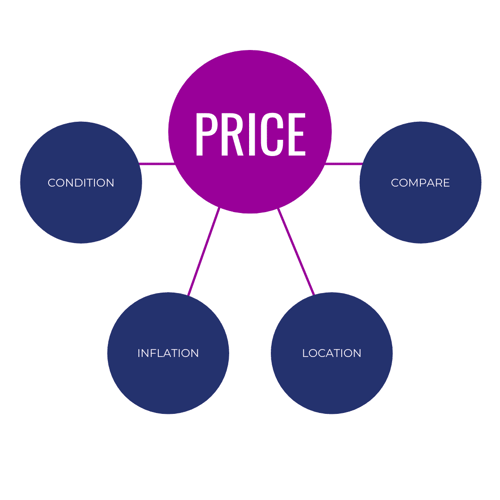Property appraisals are not an exact science. The idea you can determine the exact price of someone’s home down to the pounds and pence is for the birds. Unless you have a RICS qualification and spent many years at university, putting a price on a site or house should not be considered a valuation. At best it is a prediction on how the market will react and then justifying your opinion based on as much data as possible.
Many developers and investors call in the local estate agents to give them an appraisal even up till now despite the wealth of data available. Property appraisals might not be an exact science, but anyone can do it.
There are only 4 key areas that will ever be taken into consideration when trying to determine the price of the property (Please see very-basic diagram). The 4 elements all have an impact on the price, and it is about balancing these elements to have an informed decision of how the market will perceive the property.
Condition
It goes without saying that the condition is a major factor in arriving at a sensible price but honestly some homeowners can be biased. Condition is about whether the property meets modern standards of interior design and structural integrity. For example, if the kitchen has all nice new nerf appliances and granite work tops but the back wall has massive evidence of subsidence. The other will cancel it out. If you are a developer or an experienced investor you will know the going rate for works to be carried (if you are unsure, phone a few builders, do some research on what they charge or even better invite them to have a look). Deduct the full cost of works to the overall market value of this house in the great condition and it will help you arrive at a sensible price.
COST OF WORK – FULL MARKET VALUE
= CURRENT MARKET VALUE

You might well be asking how do I know the full market value yet? This will all be explained by comparing later. Be sensible though, the cost of getting a painter in to ‘re-do’ all the skirting boards is not going to affect the value. This is because the market will perceive this as too small to affect the overall value – most likely because they could do it themselves in one weekend with no experience. A great way to explore the condition externally of a property is through the historical street view on Nimbus Maps. It will show the properties condition for the outside from up to 15 years ago, which will show any alterations.
Inflation of properties
Inflation is a developer’s best friend because it means the average property price can increase from the time a project is started till it ends. This creates a natural profit margin albeit small in underwhelming areas but if you buy in somewhere up and coming that can be a massive boost to the overall success of the project.
Inflation is also used as a tool to determine the price of a property you are buying. If you access the previous sold price. For example:
If you buy a house for £290,000 in 2016 and prices have increased by 31% (£89,000) since then the chances are the property is roughly worth £379,000 (in 2021) if in good condition.
PREVIOUS SOLD PRICES + INFLATION = CURRENT MARKET VALUE
The previous sold prices are so easy to come by because they are all listed on the land registry records which is integrated into the Nimbus Maps platform. Bear in mind it takes 6 months from completion for the land registry to release the records.
Location of your property
If you have ever stumbled across channel 4 on a Thursday night during lockdown then Kirsty and Phil will certainly ensure this word is ringing in your ears anytime someone mentions property prices.
To be fair they have a point because Location is EVERYTHING.
In a housing crisis, the property will sell, it just does. There is a buyers for all kinds, but the location will determine (alongside the other 3 factors) for how much. Properties situated in an area of outstanding natural beauty will certainly be worth more than properties on the doorstep of a nuclear power plant in fear of a Chernobyl 2.0. However, these prices will be reflected in the average house price for that postcode.

What is not always apparent is some properties for example may benefit from sea views on one side and the other side of the street staring at a cliff face. Investigate the location and see if you can spot any differences in the previous house sold prices based on their positioning.
Compare the price of properties
Comparable evidence is the benchmark for any negotiation in the price. Exploring what other properties have sold for in similar size, location and condition will help support any opening bid. Find as many properties as you can within 0.25 – 0.5 of a mile and apply the same formulas of condition and inflation to see how they compare and this will support the price you have arrived at. The older the comparable the less accurate it will be so try to use the most recent examples. The more like-for-like the comparable evidence, the more like-for-like the price.
All the data needed to make an accurate price assessment of your next project is available in Nimbus Maps, book a free personalised demo today!
Key reads on the Nimbus blog
At Nimbus, we're committed to making property search, analysis and decision-making faster, smarter and more accessible. That's why we’re thrilled to announce a series of powerful updates that expand and enhance your experience whe...
The post-pandemic world hasn’t just changed where we work—it’s fundamentally reshaped what the office means. In cities across the UK, once-prized corporate spaces are now sitting underutilised, prompting CRE professionals to ask a...
Chancellor Rachel Reeves' Spring Statement of 2025 has unveiled bold measures to rejuvenate the UK's property sector, focusing on tackling the housing shortage, driving economic growth, and improving housing affordability. In this...
UK solar and energy storage market report 2025 Introduction The UK’s solar energy and battery storage sector is undergoing a rapid transformation, bolstered by ambitious climate targets and supportive policies. Solar photovoltaics...